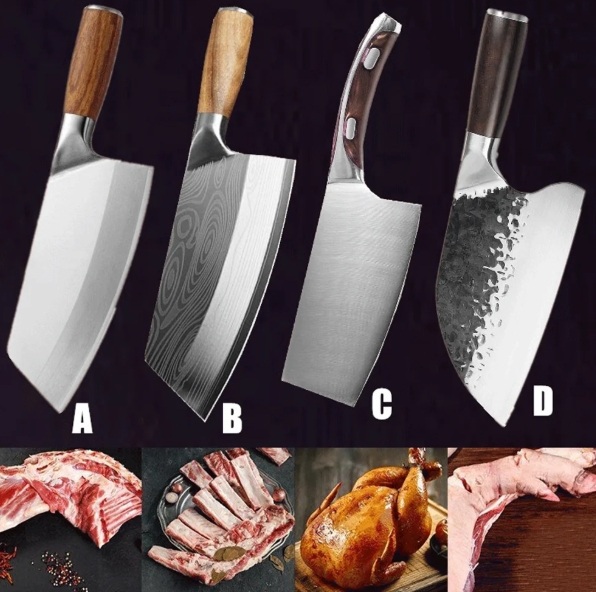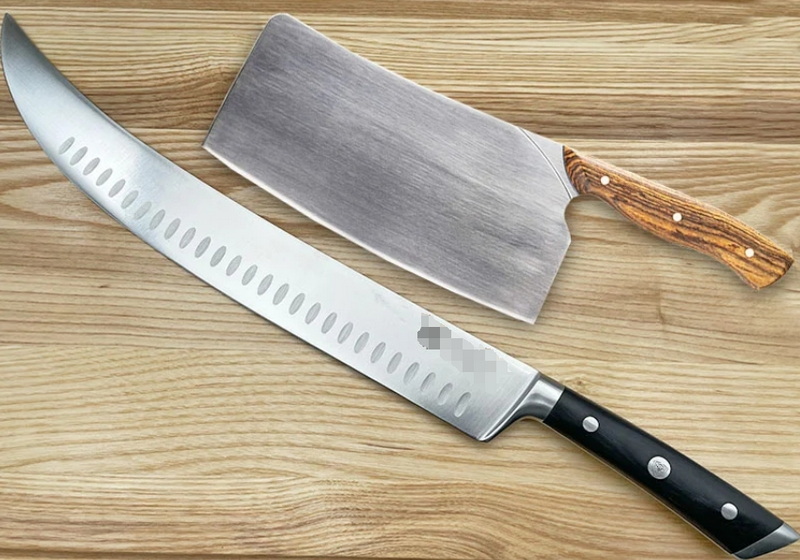

Views: 222 Author: Ella Publish Time: 2025-04-16 Origin: Site








Content Menu
● Understanding the Basics: Kitchen Knife and Cleaver
● Blade Design and Construction
● Functionality: Which Knife Excels at Meat Preparation?
>> Kitchen Knife (Chef's Knife)
>> Meat Cleaver
● Practical Uses and Cutting Techniques
>> Using a Kitchen Knife for Meat
>> Using a Meat Cleaver for Meat
>> Using a Chinese Cleaver for Meat
● FAQ
>> 1. What is the main difference between a kitchen knife and a cleaver?
>> 2. Can I use a cleaver for all meat-cutting tasks?
>> 3. What is a Chinese cleaver, and how is it different from a meat cleaver?
>> 4. How do I maintain and sharpen these knives?
>> 5. Which knife is better for home cooks who prepare meat occasionally?
When it comes to preparing meat in the kitchen, choosing the right knife can make all the difference. Two of the most commonly debated tools are the kitchen knife—often represented by the chef's knife—and the cleaver. Both have distinct designs, purposes, and advantages, especially when it comes to handling meat. This comprehensive guide will explore the differences between kitchen knives and cleavers, their ideal uses, and which might be better suited for your meat preparation needs.

The kitchen knife, especially the chef's knife, is a versatile tool found in almost every kitchen. It typically features a curved blade, ranging from 6 to 12 inches, designed for slicing, dicing, chopping, and mincing a variety of ingredients, including meat, vegetables, and herbs. The curved blade allows for a rocking motion that facilitates precision cutting and fine slicing[13][6].
A cleaver is a large, rectangular-bladed knife known for its heft and power. It is designed primarily for heavy-duty tasks such as chopping through bones, cartilage, and dense meat cuts. Cleavers come in two main types:
- Meat Cleaver (Western style): Thick, heavy, and blunt-edged, ideal for hacking through bones and tough meat[4][9].
- Chinese Cleaver (Chinese chef's knife): Thinner and lighter than a meat cleaver, versatile for slicing meat, vegetables, and crushing garlic, often mistaken for a cleaver but functions more like a chef's knife[2][9].
| Feature | Kitchen Knife (Chef's Knife) | Cleaver (Meat Cleaver) | Chinese Cleaver (Vegetable Cleaver) |
|---|---|---|---|
| Blade Shape | Curved, pointed tip | Large, rectangular, blunt edge | Large rectangular but thinner and sharper |
| Blade Thickness | Thin to medium | Very thick and heavy | Medium thickness, thinner than meat cleaver |
| Blade Length | 6 to 12 inches | 4 to 8 inches | 6 to 10 inches |
| Weight | Light to medium | Heavy (1 to 3 pounds) | Light to medium |
| Cutting Motion | Rocking motion for precision | Up and down chopping/hacking | Push and tap chopping, slicing, crushing |
| Edge Sharpness | Very sharp for fine slicing | Less sharp, designed for blunt force | Sharp edge for slicing, less for bone cutting |
The kitchen knife's curved blade is designed for precision and versatility, making it excellent for slicing meat thinly and delicately. The cleaver's broad, heavy blade delivers power and momentum to chop through bones and tough meat with a single chop[2][11][8].
- Best for: Slicing boneless meat, trimming fat, precision cutting, and delicate tasks like filleting or mincing herbs to accompany meat dishes[1][13].
- Advantages: Its sharp, curved blade allows for smooth slicing and dicing, making it ideal for preparing steaks, roasts, or thin cuts of meat.
- Limitations: Not suitable for chopping through bones or very tough connective tissue; attempting to do so can damage the blade.
- Best for: Breaking down large cuts of meat, chopping through bones, cartilage, and dense connective tissue[4][8].
- Advantages: The heavy blade uses momentum to chop through tough materials efficiently, reducing effort and protecting other knives from damage.
- Limitations: Not designed for delicate slicing or fine cuts; the blade is too thick and blunt for precision work.
- Best for: Versatile kitchen tasks including slicing boneless meat, chopping vegetables, crushing garlic, and light breaking of small bones or shells[9][2].
- Advantages: Combines the versatility of a chef's knife with the broad blade's utility for crushing and scooping ingredients.
- Limitations: Not suitable for heavy bone chopping; the blade is thinner and less robust than a meat cleaver.

- Ideal for trimming fat and sinew from meat cuts.
- Perfect for slicing steaks, roasts, and fillets into uniform pieces.
- Allows for precision cuts around joints and bones without damaging the meat.
- Employs a rocking motion to create smooth, clean slices[1][6].
- Best for breaking down whole chickens, large cuts of beef, pork ribs, and other bone-in meats.
- Use an up-and-down chopping motion to split bones and cartilage with one powerful chop.
- The broad side of the blade can tenderize meat or crush garlic and nuts[4][11].
- Not recommended for prolonged use by novices due to its weight and required technique.
- Excellent for slicing boneless meat and vegetables with a push or tap chopping motion.
- The broad blade can crush garlic and ginger, and scoop ingredients for transfer.
- Can break small bones or crab shells but not large or thick bones[9][2].
- Kitchen Knife: Requires regular honing and sharpening to maintain a fine edge. Best sharpened with a whetstone or professional sharpening service[10][13].
- Meat Cleaver: Due to its thick blade and blunt edge, it requires less frequent sharpening but should be maintained to avoid chipping. Sharpening angle is wider than kitchen knives[4][11].
- Chinese Cleaver: Sharpened similarly to chef's knives, often with a whetstone. Requires care to maintain the sharp edge due to thinner blade[5][9].
When deciding between a kitchen knife and a cleaver for meat preparation, the choice depends largely on the task at hand:
- For precision slicing, trimming, and delicate cuts, a kitchen knife (chef's knife) is superior due to its sharp, curved blade and versatility.
- For heavy-duty chopping through bones and tough meat, a meat cleaver is the better tool, offering power and durability.
- The Chinese cleaver strikes a balance, serving as a versatile all-purpose knife suitable for slicing boneless meat and vegetables, but not for heavy bone chopping.
Ultimately, many professional kitchens benefit from having both knives available, using each where it excels. For home cooks, understanding your cooking style and the types of meat you frequently prepare will guide you to the right choice.

The kitchen knife has a curved, sharp blade designed for precision slicing and chopping, while the cleaver has a large, heavy, rectangular blade designed for chopping through bones and tough meat[2][11].
No, cleavers are best for heavy chopping through bones and tough cuts. They are not suitable for delicate slicing or trimming, which requires a sharper, thinner blade like a kitchen knife[4][9].
A Chinese cleaver is a thinner, lighter, and sharper knife used for slicing meat and vegetables, crushing garlic, and general kitchen prep. A meat cleaver is thicker, heavier, and designed for chopping bones and tough meat[9][2].
Kitchen knives and Chinese cleavers should be sharpened regularly with a whetstone or professional service. Meat cleavers require less frequent sharpening but need to maintain a blunt edge suitable for chopping[5][10].
For occasional meat preparation, a versatile kitchen knife or Chinese cleaver is usually sufficient. A meat cleaver is recommended if you frequently break down large cuts or bone-in meat[13][8].
[1] https://www.reddit.com/r/Cooking/comments/tkhgbm/chinese_cleaver_vs_chefs_knife/
[2] https://dexter1818.com/uncategorized/the-battle-of-blades-cleaver-vs-chinese-chefs-knfe/
[3] https://www.youtube.com/watch?v=1sBZtMAOuIk
[4] https://www.koiknives.com/blogs/japanese-knives/meat-cleaver-faqs
[5] https://www.seriouseats.com/chinese-cleaver-kitchen-knife
[6] https://www.youtube.com/watch?v=yrirsfaas3Q
[7] https://madeincookware.com/blogs/types-of-kitchen-knives
[8] https://www.cozymeal.com/magazine/butcher-knife-vs-cleaver
[9] https://cutleryandmore.com/blogs/knives/chinese-cleaver
[10] https://www.youtube.com/watch?v=go2cNuRRu3g
[11] https://seidoknives.com/blogs/news/cleavers-vs-butcher-knives
[12] https://chefsvisionknives.com/blogs/chefs-vision-blog/boning-knife-vs-cleaver-the-differences
[13] https://cookingpanda.com/blogs/food-news/chinese-cleaver-vs-chef-knife
[14] https://www.youtube.com/watch?v=o_QWK4AC7R0
[15] https://www.nytimes.com/wirecutter/blog/why-i-use-a-chinese-cleaver/
[16] https://www.seriouseats.com/chinese-cleaver-kitchen-knife
[17] https://www.istockphoto.com/photos/meat-cleaver-knife
[18] https://www.reddit.com/r/ZombieSurvivalTactics/comments/gbm7j2/terrible_weapons_7_kitchen_knife_vs_cleaver/
[19] https://www.pinterest.com/pin/butcher-knife-vs-cleaver-whats-the-difference--656751558177674677/
[20] https://www.kitchenknifeforums.com/threads/rangens-cleaver-and-knife-gallery.7382/
[21] https://stock.adobe.com/search?k=butcher+cleaver
[22] https://www.youtube.com/watch?v=HdlmaKelgfY
[23] https://www.youtube.com/watch?v=Z1C5ePSFY4c
[24] https://www.youtube.com/watch?v=o_QWK4AC7R0
[25] https://www.youtube.com/watch?v=anxN1b8bdnA
[26] https://www.reddit.com/r/chefknives/comments/ngdsyy/the_video_that_helped_explain_the_basics_of_chef/
[27] https://www.kitchenknifeforums.com/threads/cleaver-vs-cleaver.39022/
[28] https://elementknife.com/pages/common-questions-about-kitchen-knives
[29] https://cdn.shopify.com/s/files/1/0425/2699/8690/files/Chinese_Cleaver_Vs_Chef_Knife_1_480x480.png?v=1705395566&sa=X&ved=2ahUKEwius9O_8dyMAxUQlJUCHShwMJkQ_B16BAgBEAI
[30] https://www.thebambooguy.com/blogs/kitchen-knives/frequently-asked-questions-about-kitchen-knives
[31] https://www.reddit.com/r/Cooking/comments/ipqtc/knife_skills_and_cleaver_questions/
[32] https://www.kitchenknifeforums.com/threads/cleaver-questions-comparison-help.22520/
[33] https://artisanrevere.com/blogs/education/knife-faq-and-problem-solving
[34] https://www.chefknivestogoforums.com/viewtopic.php?t=6382
[35] https://www.tophamknifeco.com/frequently-asked-questions/